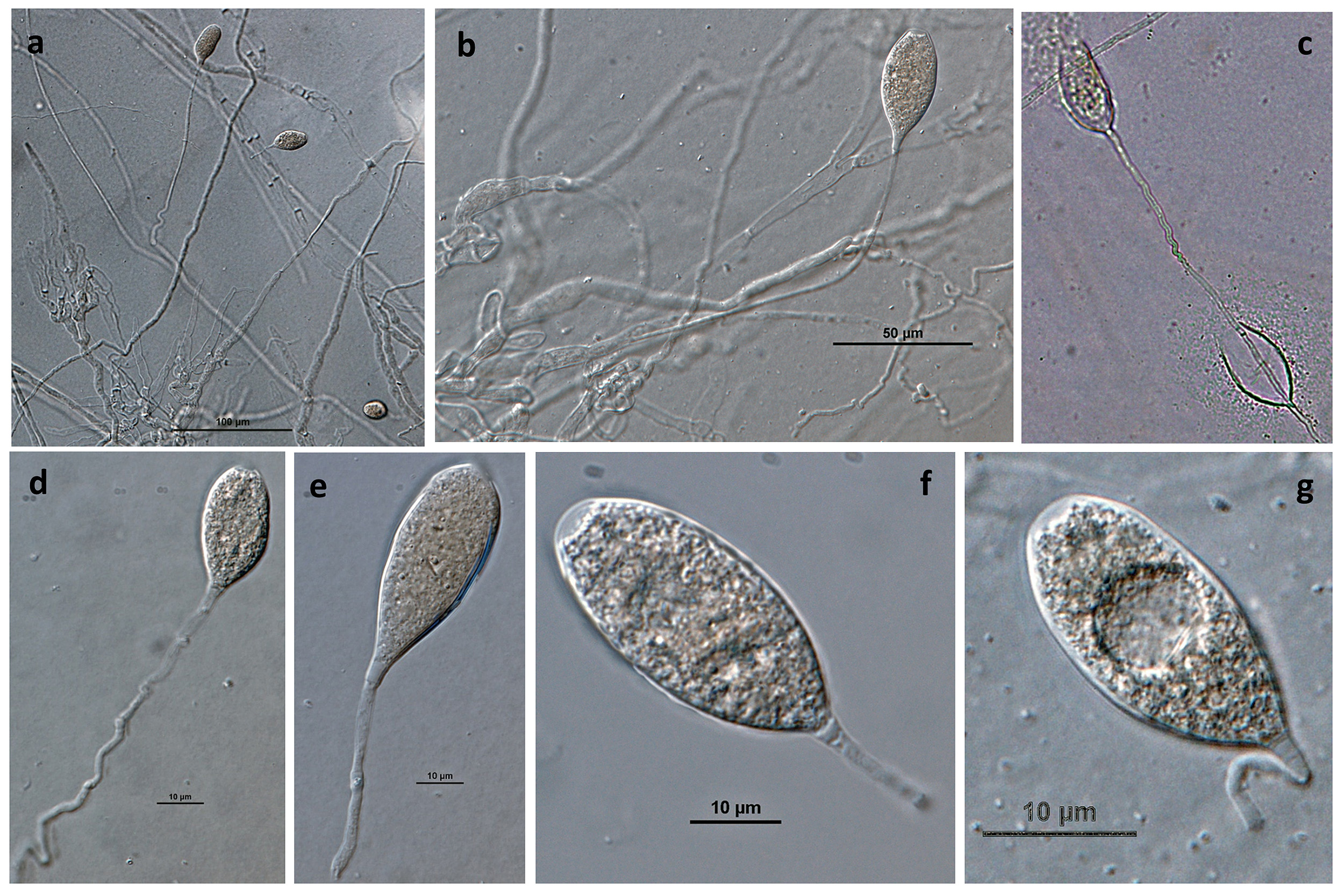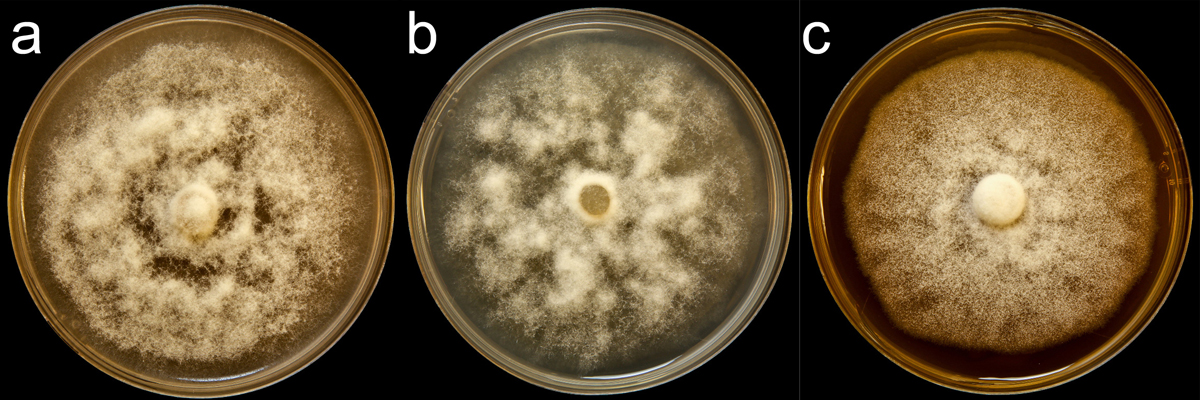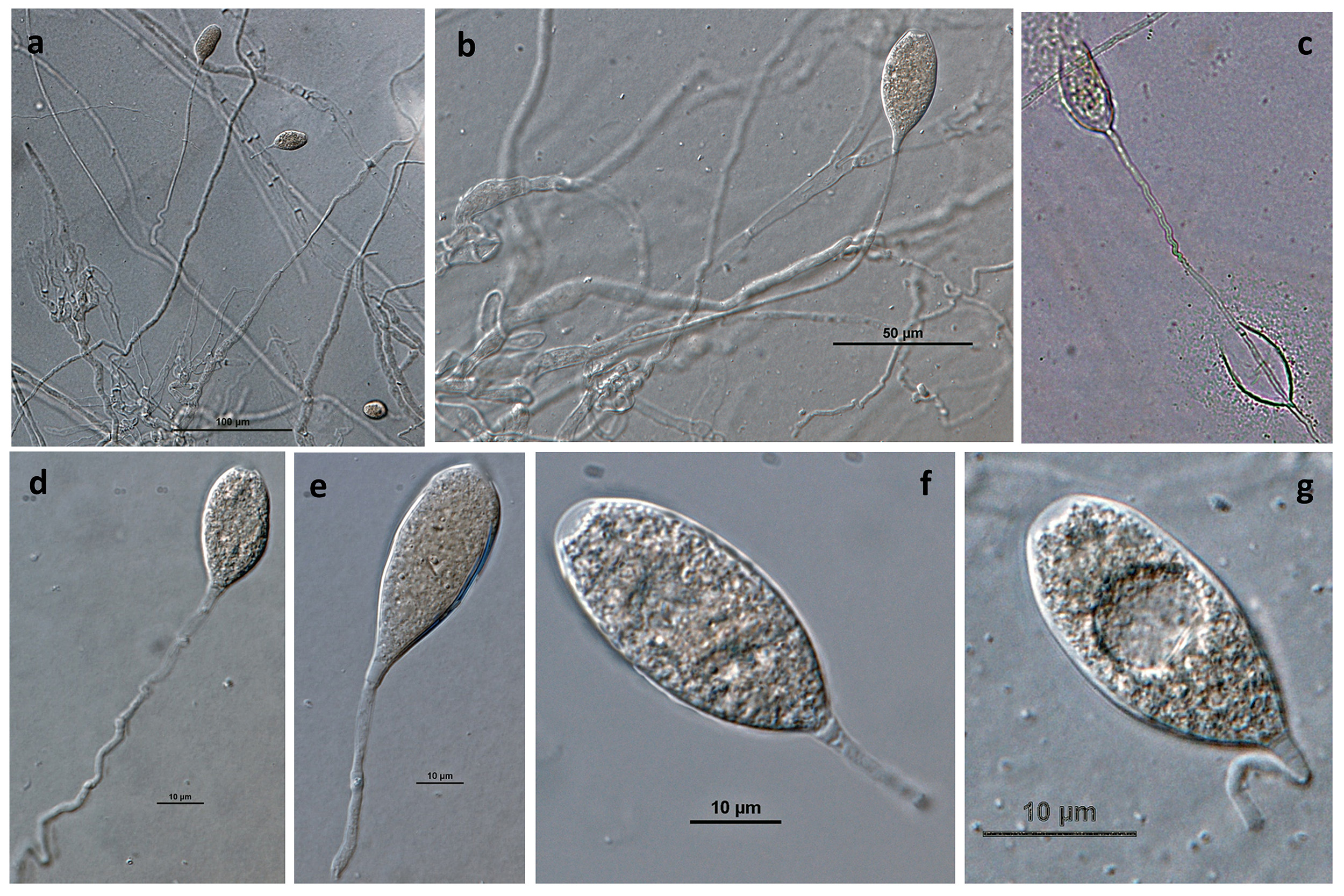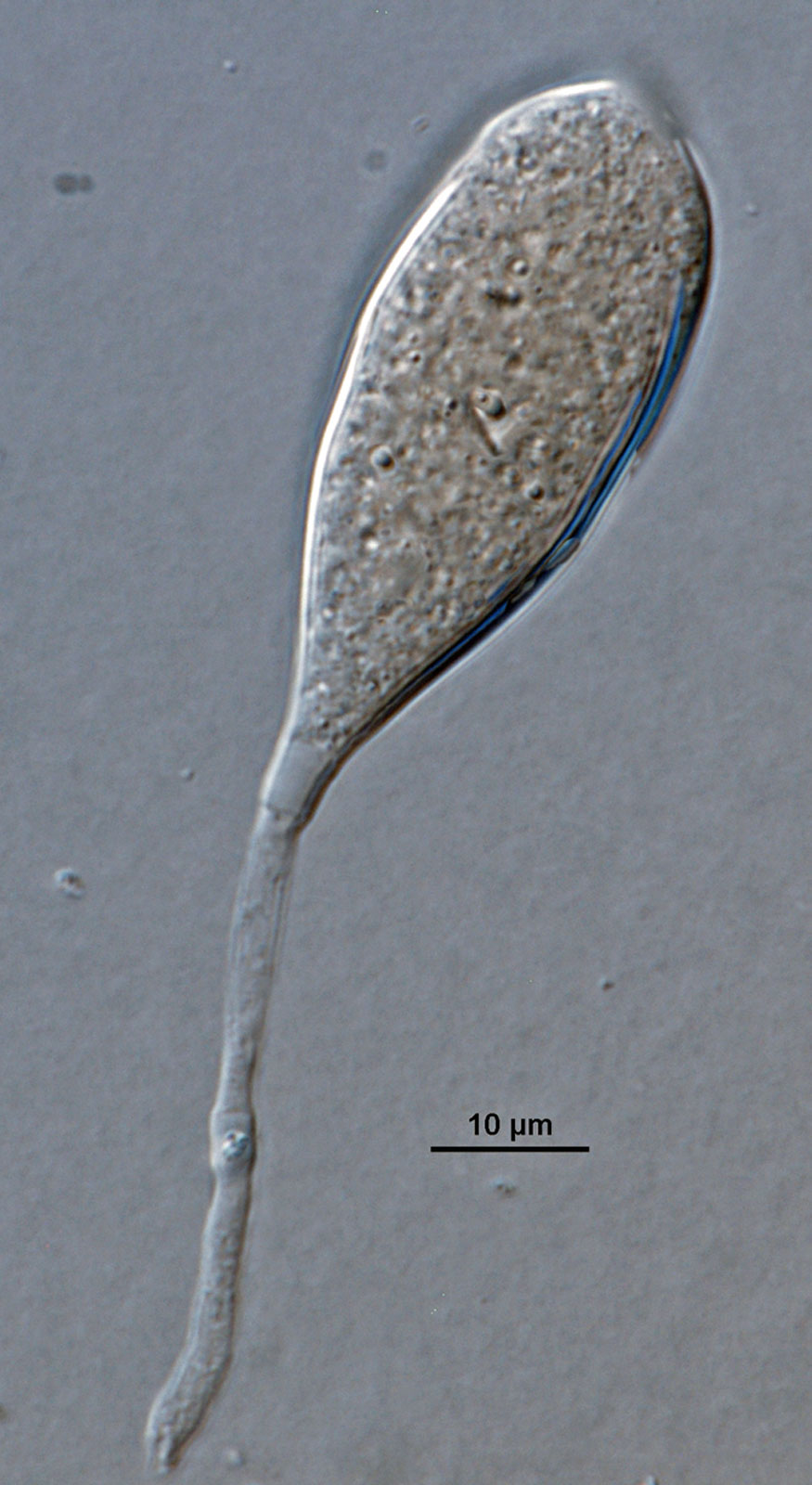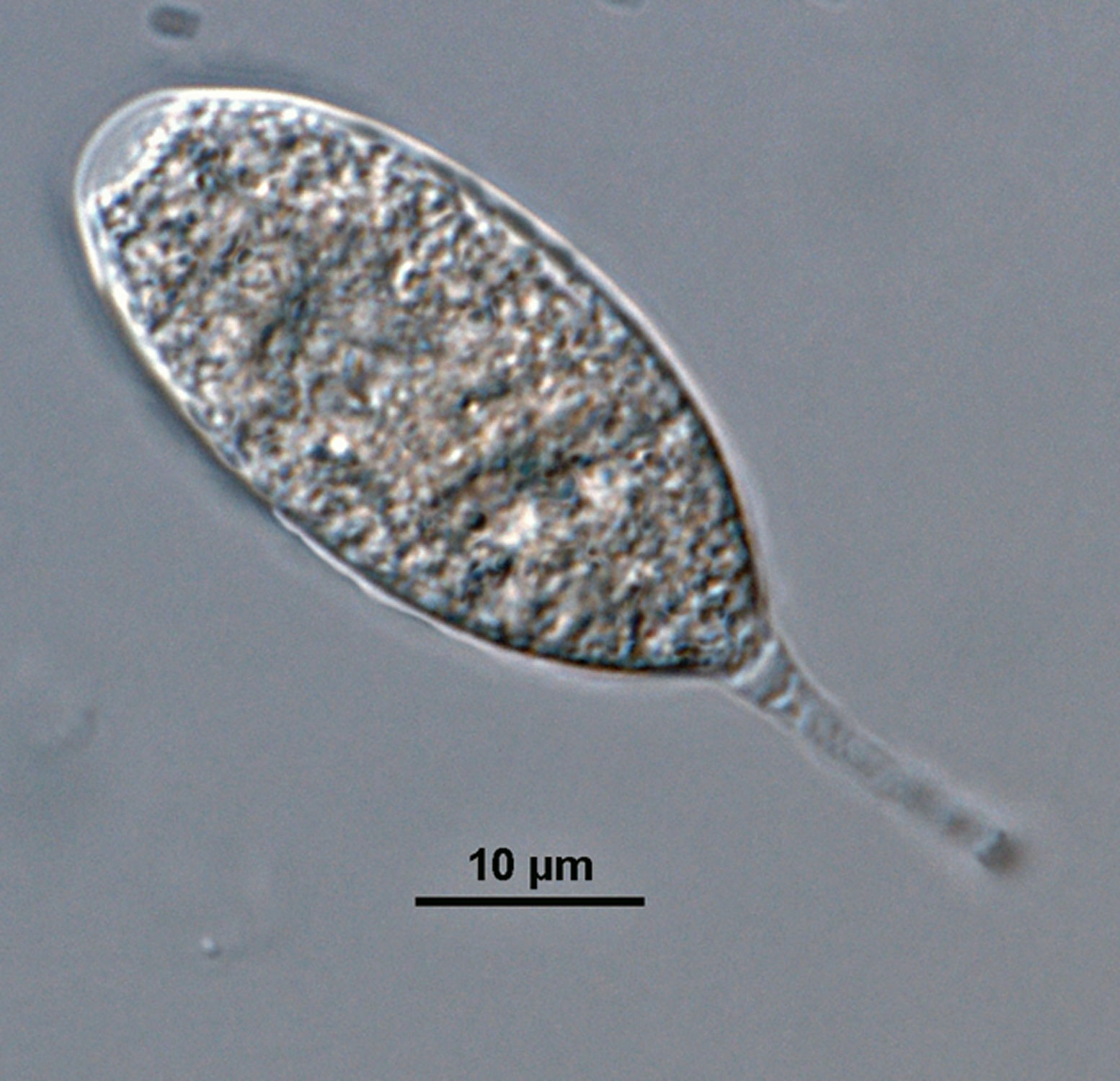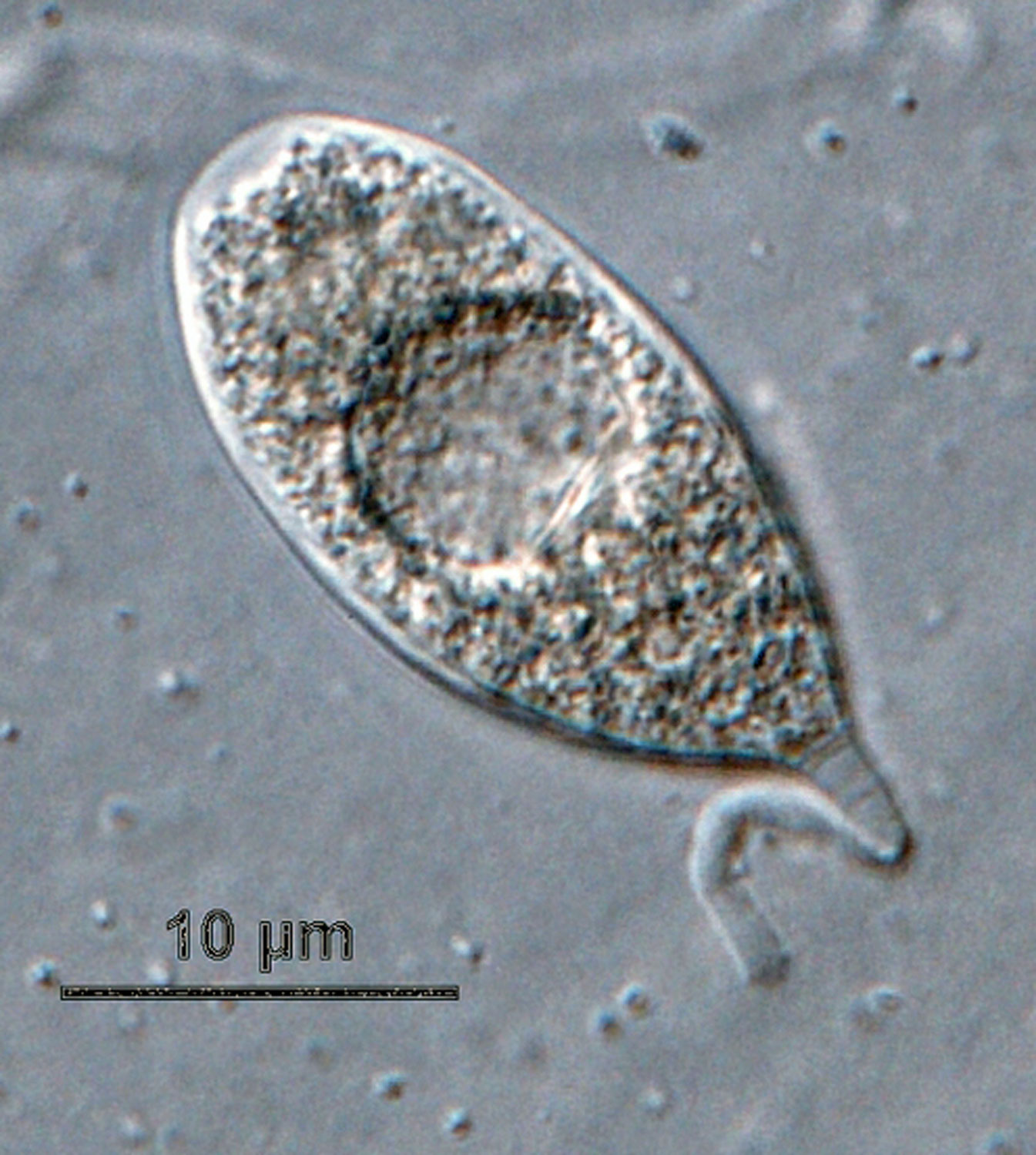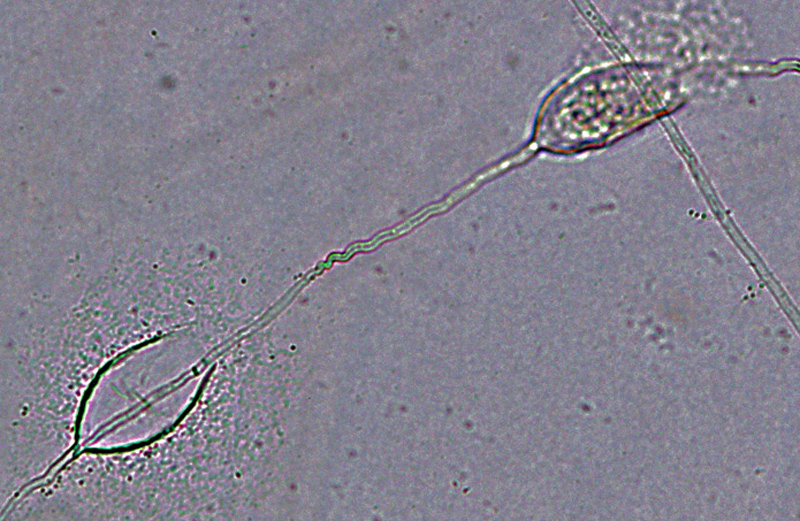Phytophthora melonis
|
Phytophthora spp. in subclade 7b: portion of the seven-loci ML phylogeny featuring the type cultures of 212 described species (by T. Bourret). Notice the position of P. melonis Ex-type CBS 582.69 = S&T BL 23. Gloria Abad, USDA S&T.
|
|
Phytophthora spp. in subclade 7b: Morphological Tabular key (PDF) and Tabular key legends (PDF) in IDphy2 KEY SECTION. Notice the data of P. melonis Ex-type CBS 582.69 = S&T BL 23. Gloria Abad, USDA S&T.
|
|
Phytophthora melonis (CPHST BL 23) colonies of the ex-type grown for 7 days on (a) V8® Agar, (b) potato dextrose agar, and (c) malt extract agar; photo by Krysta Jennings and Leandra Knight, USDA-APHIS-PPQ |
|
Phytophthora melonis (CPHST BL 159) colonies of a selected specimen grown for 7 days on (a) V8® Agar, (b) potato dextrose agar, and (c) malt extract agar; photo by Krysta Jennings and Leandra Knight, USDA-APHIS-PPQ |
|
Phytophthora melonis (CPHST BL 160) colonies of a selected specimen grown for 7 days on (a) V8® Agar, (b) potato dextrose agar, and (c) malt extract agar; photo by Krysta Jennings and Leandra Knight, USDA-APHIS-PPQ |
|
|
|
Phytophthora melonis (CPHST BL 23, ex-type) asexual phase showing nonpapillate sporangia (a–g), sometimes caducous with medium to long pedicels (e–g), hyphal swellings (a, b), and internal proliferation (c); photos by Gloria Abad USDA-APHIS-PPQ. |
|
Phytophthora melonis (CPHST BL 23, ex-type) asexual phase: nonpapillate sporangium with medium length pedicel; photo by Gloria Abad USDA-APHIS-PPQ. |
|
Phytophthora melonis (CPHST BL 23, ex-type) asexual phase: nonpapillate sporangium with long pedicel; photo by Gloria Abad USDA-APHIS-PPQ. |
|
Phytophthora melonis (CPHST BL 23, ex-type) asexual phase: nonpapillate sporangium with medium length pedicel; photo by Gloria Abad USDA-APHIS-PPQ. |
|
Phytophthora melonis (CPHST BL 23, ex-type) asexual phase: nonpapillate sporangium with long pedicel; photo by Gloria Abad USDA-APHIS-PPQ. |
|
Phytophthora melonis (CPHST BL 23, ex-type) asexual phase: nonpapillate sporangia with long pedicels; photo by Gloria Abad USDA-APHIS-PPQ. |
|
Phytophthora melonis (CPHST BL 23, ex-type) asexual phase: nonpapillate sporangium with medium length pedicel; photo by Gloria Abad USDA-APHIS-PPQ. |
|
Phytophthora melonis (CPHST BL 23, ex-type) asexual phase: sporangia with internal proliferation; photo by Gloria Abad USDA-APHIS-PPQ. |
Name and publication
Phytophthora melonis Katsura (1976)
Katsura K. 1976. Two new species of Phytophthora causing damping-off of cucumber and trunk rot of chestnut. Trans. Mycol. Soc. Jpn. 17: 238–242.
Nomenclature
Mycobank
Synonymy
= Phytophthora sinensis Y.N. Yu & W.Y. Zhuang 1982. Note: Synonymy supported by molecular analysis (Cooke et al. 2000).
Typification
from Katsura (1976)
Type: JAPAN, from cucumber (Cucumis sativus) collected in Kyoto Prefectural University, Plant Pathology Herbarium No 1967-008
Ex-type: culture deposited at Centraalbureau voor Schimmelcultures CBS 582.69
NOTE: Specimen CBS 582.69 is LOST from CBS, according to e-mail of A. De Cock to G. Abad on 2-21-14.
Ex-type in other collections
(ET) CBS 582.69, NRRL 64013, ATCC 52854, WPC P6870, S&T BL 23, No. P 10-4-1, Ho 513, H27.2, 45F3 (Hong)
Molecular identification
Voucher sequences for barcoding genes (ITS rDNA and COI) of the ex-type (see Molecular protocols page)
Phytophthora melonis isolate CPHST BL 23 (= P6870 WPC) = ITS rDNA MG865536, COI MH136931
Voucher sequences for Molecular Toolbox with seven genes (ITS, β-tub, COI, EF1α, HSP90, L10, and YPT1
(see Molecular protocols page) (In Progress)
Voucher sequences for Metabarcoding High-throughput Sequencing (HTS) Technologies [Molecular Operational Taxonomic Unit (MOTU)]
(see Molecular protocols page) (In Progress)
Sequences with multiple genes for ex-type in other sources
- NCBI: Phytophthora melonis CPHST BL 23
- NCBI: Phytophthora melonis P6870
- NCBI: Phytophthora melonis CBS 582.69
- NCBI: Phytophthora melonis CBS 582.69
- EPPO-Q-bank: Phytophthora melonis CBS 582.69
- BOLDSYSTEMS: Phytophthora melonis OOMYA198.07 [COI-5P:680, ITS:826] = CBS 582.62; OOMYA531.08 [ITS:2307] = CBS 582.62; PHYTO205-10 [COI-5P:680, ITS:826] = P6870 (barcoding COI & ITS)
Position in multigenic phylogeny with 7 genes (ITS, β-tub, COI, EF1α, HSP90, L10, and YPT1)
Clade 7b
Genome sequence
Phytophthora melonis strain ex-type BL 23. Accession genome USDA_Pmel_BL23_1.0 reference, BioProject PRJNA556690, USDA-APHIS-PPQ-S&T (2019), Srivastava et al. 2020
Morphological identification
Colonies and cardinal temperatures
Colony colony:
assemblage of hyphae which usually develops form a single source and grows in a coordinated way
morphology after 7 days of growth on V8 agar, potato dextrose agar, and malt extract with no distinct pattern to slightly radiate. Minimum temperature for growth is 9°C, optimum 28–32°C, and maximum 37°C.
Asexual phase
SporangiaSporangia:
sac within which zoospores form, especially when water is cooled to about 10°C below ambient temperature; in solid substrates, sporangia usually germinate by germ tubes
nonpapillatenonpapillate:
pertaining to the production of a non-distinct, or inconspicuous, papilla at the distal end of the sporangium (cf. papillate and semipapillate)
with internal proliferationinternal proliferation:
internal proliferation occurs when the sporangiophore continues to grow through an empty sporangium
; persistentpersistent:
pertaining to sporangia that remain attached to the sporangiophore and do not separate or detach easily (cf. caducous)
, sometimes caducouscaducous:
pertaining to sporangia that become dislodged readily (i.e. deciduous) and separate from the sporangiophore (cf. persistent)
with medium to long pedicels; ovoidovoid:
egg-shaped, with the widest part at the base of the sporangium and the narrow part at the apex
, obpyriformobpyriform:
inversely pear-shaped, i.e. with the widest part at the point of attachment (cf. pyriform)
with round bases (32–75 x 23–45 μm diam.), produced in long unbranched sporangiophores. Hyphal swellings occasionally produced, globoseglobose:
having a rounded form resembling that of a sphere
, terminal and intercalaryintercalary:
positioned within a hypha (cf. terminal)
, some with radiating hyphaehyphae:
single, tubular filament of a fungal or oomycete thallus; the basic structural unit of a fungus or oomycete
. ChlamydosporesChlamydospores:
an asexual spore with a thickened inner wall that is delimited from the mycelium by a septum; may be terminal or intercalary, and survives for long periods in soil
spherical (16–52 μm diam.).
Sexual phase
Heterothallic. OogoniaOogonia:
the female gametangium in which the oospore forms after fertilization by the antheridium
smooth-walled (27–35 μm diam.); antheridiaantheridia:
the male gametangium; a multinucleate, swollen hyphal tip affixed firmly to the wall of the female gametangium (the oogonium)
amphyginous (10–29 x 10–20 μm); oosporesoospores:
zygote or thick-walled spore that forms within the oogonium after fertilization by the antheridium; may be long-lived
pleroticplerotic:
pertaining to an oospore that fills the oogonium (cf. aplerotic)
to slightly apleroticaplerotic:
pertaining to a mature oospore that does not fill the oogonium; i.e. there is room left between the oospore wall and oogonium wall (cf. plerotic)
.
Ho et al. (2007) presented the "redescription of Phytophthora melonis" and indicated that the species doesn't produce chlamydosporeschlamydospores:
an asexual spore with a thickened inner wall that is delimited from the mycelium by a septum; may be terminal or intercalary, and survives for long periods in soil
. However, in this study the isolate of the ex-type (i.e. CBS582.69 = P6870 (WPC), ATCC 52854) was not evaluated. Also, this study describes the species as nonpapillated, and the original manuscript indicates semipapillated sporangiasporangia:
sac within which zoospores form, especially when water is cooled to about 10°C below ambient temperature; in solid substrates, sporangia usually germinate by germ tubes
. The original publication describes "apice papillapapilla:
a small rounded or conic protuberance, generally translucent, on the wall of sporangia that breaks open and serves as the exit-point of zoospores
plana", and the figures correspond to nonpapillated sporangiasporangia:
sac within which zoospores form, especially when water is cooled to about 10°C below ambient temperature; in solid substrates, sporangia usually germinate by germ tubes
.
Most typical characters
Phytophthora melonis is characterized by the presence of nonpapillatenonpapillate:
pertaining to the production of a non-distinct, or inconspicuous, papilla at the distal end of the sporangium (cf. papillate and semipapillate)
sporangia with internal proliferationinternal proliferation:
internal proliferation occurs when the sporangiophore continues to grow through an empty sporangium
.
Specimen(s) evaluated
Phytophthora melonis ex-type CPHST BL 23, duplicate of P6870 (World Oomycetes/Phytophthora Collection)
Phytophthora melonis CPHST BL 159 (A1) Cucumis sativus (China), duplicate of P1371 (World Oomycetes/Phytophthora Collection)
Phytophthora melonis CPHST-BL 160 Trichosanthes dioica (India), duplicate of P10994 (World Oomycetes/Phytophthora Collection)
Hosts and distribution
Distribution: Asia
Substrate: stems, vines, fruits, leaves
Disease note: late blight or foot rot
Host: Cucumis sativus (cucumber, Cucurbitaceae); also reported from Citrullus lanatus (Cucurbitaceae) and Pistacia vera (Anacardiaceae)
Retrieved January 31, 2018 from U.S. National Fungus Collections Nomenclature Database.
Additional Info
Substrate: roots
Quarantine status
USA: This species was listed as a species of concern during the 2009 Phytophthora prioritization project conducted by USDA APHIS PPQ CPHST PERAL (Schwartzburg et al.).
Additional references and links
Katsura K. 1976. Two new species of Phytophthora causing damping-off of cucumber and trunk rot of chestnut. Trans. Mycol. Soc. Jpn. 17: 238–242.
Ho HH, Gallegly ME, and Hong CX. 2007. Redescription of Phytophthora melonis. Mycotaxon 102: 339–345.
- SMML USDA-ARS: Phytophthora melonis
- EPPO Global Database: Phytophthora melonis
- Forest Phytophthora of the world: Phytophthora melonis
- CABI Digital Library: Phytophthora melonis
- Encyclopedia of Life (EOL): Phytophthora melonis
- Index Fungorum (IF): Phytophthora melonis
- Google All Phytophthora melonis
- Google Images Phytophthora melonis
- Google Scholar Phytophthora melonis
Fact sheet author
Z. Gloria Abad, Ph.D., USDA-APHIS-PPQ-S&T Plant Pathogen Confirmatory Diagnostics Laboratory (PPCDL), United States of America.

